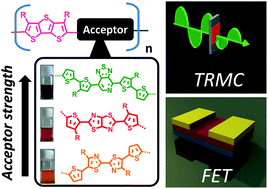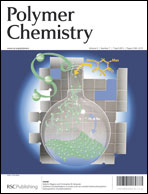Herein we report the systematic study of the structure–property relationship of a few dithienothiophene (DTT) based donor–acceptor conjugated polymers using various techniques such as UV-vis absorption and fluorescence spectroscopy, cyclic voltammetry (CV), flash-photolysis time-resolved microwave conductivity (FP-TRMC), density functional theory (DFT), X-ray diffraction (XRD), and field-effect transistor (FET). A medium donor, DTT, was coupled in an alternating fashion with thiazole-based weak, medium, and strong acceptors. Though the optical properties showed good correlation with the donor–acceptor strength, the FET properties indicated significant deviation. The XRD analysis and DFT calculations revealed that the deviation is caused by the difference in structural ordering of the polymers in the film state. Since the FP-TRMC analysis reflects the properties of semiconducting organic materials at the molecular level such as the donor–acceptor strength and structural ordering in the film state, it showed good correlation with FET properties. Thus the present work illustrates that the study of charge carrier generation and mobility dynamics by FP-TRMC is a valuable addition to the conventional structure–property analysis methods, and is reliable to find the suitability of conjugated polymers for electronic device applications.

You have access to this article
 Please wait while we load your content...
Something went wrong. Try again?
Please wait while we load your content...
Something went wrong. Try again?


 Please wait while we load your content...
Please wait while we load your content...